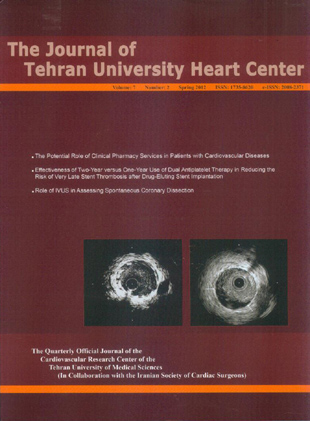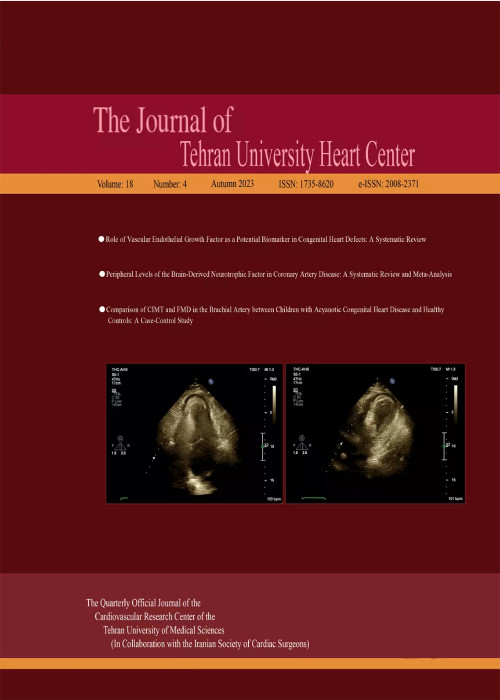فهرست مطالب

The Journal of Tehran University Heart Center
Volume:7 Issue: 2, Apr 2012
- 106 صفحه،
- تاریخ انتشار: 1391/05/05
- تعداد عناوین: 10
-
-
Page 41Clinical pharmacy is deemed an integral component of a health care system. The presence of clinical pharmacists in medical rounds could assist physicians in optimizing patients'' pharmacotherapy. Moreover, clinical pharmacists may reduce adverse effects and medication errors insofar as they contribute significantly to the detection and management of drug-related problems, not least in patients with cardiovascular diseases, who have the highest rank in the frequency of medication errors. Clinical pharmacists can also collaborate with physicians in the management of cardiovascular risk factors as well as anticoagulation therapy based on patients’ specific situations. In summary, the practice of clinical pharmacy is considered a crucial part of a health care team to improve the level of patients'' care by increasing the quality of therapy with the least expense for a health care system.Keywords: Pharmacy, Cardiovascular diseases, Professional role, Patient care team
-
Effectiveness of Two-Year versus One-Year Use of Dual Antiplatelet Therapy in Reducing the Risk of Very Late Stent Thrombosis after Drug-Eluting Stent ImplantationPage 47BackgroundImpact of 12 months’ versus 24 months’ use of dual antiplatelet therapy on the prevalence of stent thrombosis in patients undergoing percutaneous coronary intervention (PCI) with the drug-eluting stent (DES) is not clear. As a result, duration of dual antiplatelet therapy is still under debate among interventionists.MethodsFrom March 2007 until August 2008, all consecutive patients with successful PCI who received at least one DES and were treated with dual antiplatelet therapy (Clopidogrel + Aspirin) were included. All the patients were followed up for more than 24 months (mean = 35.27 ± 6.91 months) and surveyed for very late stent thrombosis and major cardiovascular events.ResultsFrom 961 patients eligible for the study, 399 (42%) discontinued Clopidogrel after 12 months and 562 (58%) continued Clopidogrel for 24 months. The clinical and procedural variables were compared between the two groups. In the 12 months’ use group, two cases of definite thrombosis occurred at 18 and 13 months post PCI. In the 24 months’ use group, 2 cases of definite thrombosis occurred at 14 and 28 months post PCI, one of them with stenting in a bifurcation lesion. Five cases of probable stent thrombosis were detected at 21, 28, 32, 33, and 34 months after the procedure. It is of note that amongst the 10 cases of stent thrombosis, only 1(10%) thrombosis occurred when the patient was on Clopidogrel and Aspirin and all the other 9 (90%) cases of thrombosis appeared after the discontinuation of the dual antiplatelet therapy.ConclusionExtended use of dual antiplatelet therapy (for more than 12 months) was not significantly more effective than Aspirin monotherapy in reducing the risk of myocardial infarction or stent thrombosis, death from cardiac cause, and stroke.Keywords: Drug, eluting stents, Clopidogrel, Angioplasty, Thrombosis
-
Page 53BackgroundSelenium (Se) is an essential trace element mainly obtained from seafood, meat, and cereals. Se deficiency has been identified as a major contributing factor in the pathogenesis of certain congestive heart failure (CHF) syndromes. Since there is controversy over the prevalence of Se deficiency among patient with CHF, the aim of this study was to assess the serum Se concentrations in patients with CHF and compared them with the Se status of healthy controls.MethodsThe study included 77 patients (age, 68.4 ± 10.4 years old; 40.3% female) and 73 healthy volunteers (64.9 ± 4.7 years old; 35.6% female). A complete medical/drug history and physical examination were performed for all patients and healthy volunteers. All patients had symptoms and signs of CHF and had a left ventricular ejection fraction (EF) of < 40% obtained by echocardiography. The Se concentration was assessed by atomic absorption spectrometer with the Graphite Tube Atomizer. The limit of measurement was 5 μg/L.ResultsThe Se concentrations in CHF patients did not show a significant difference from those of healthy controls (185.9 ± 781.2 μg/L vs. 123.3 ± 115.5 μg/L, respectively; p value = 0.499). There was no correlation between serum Se concentrations and EF in both the normal group and the patients with heart failure (p value = 0.96 and 0.99; r = 0.006 and 0.002 for patients and healthy volunteers, respectively).ConclusionIn this study, serum Se levels in CHF patients were similar to those of controls and the Se concentrations did not correlate with the degree of left ventricular dysfunction.Keywords: Selenium, Heart failure, Atrial fibrillation
-
Page 58BackgroundAtherosclerotic renal artery stenosis (ARAS) remains underdiagnosed due to its nonspecific demonstrations. We aimed to both estimate the frequency of ARAS in high-risk non-selected patients undergoing simultaneous coronary and renal catheterization and possibly identify a predictive model for ARAS using baseline clinical, laboratory, and coronary angiographic variables.MethodsThe records of 866 patients aged ≥ 21 years undergoing simultaneous coronary and renal angiography were retrieved for analysis from our computerized database. The degree of ARAS was estimated visually by experienced attending interventional cardiologists. Lesions with an estimated stenosis of ≥ 50% were considered significant. Multivariable stepwise logistic regression models were used to identify the risk factors predicting the presence and extent of ARAS.ResultsOf a total of 866 consecutive patients undergoing renal angiography in conjunction with coronary angiography (mean age ± SD: 63.06 ± 10.32, ranging from 24 to 89 years), 454 (57%) were men. A total of 345 (39.8%) cases had significant ARAS, 77 (22.3%) of which were bilateral. Using significant ARAS as the dependent variable, six variables were identified as the independent predictors significantly associated with the presence of ARAS, namely age, female sex (male sex was found to be a protector), hypertension, history of renal failure, left anterior descending artery (LAD) stenosis > 50%, and left circumflex artery (LCX) stenosis > 50%. The Gensini score was not found to be a predictor of the presence of ARAS, but it was more likely associated with a trend towards a more extensive ARAS (adjusted OR = 1.00, 95% CI = 1.00-1.01; p value = 0.039). Other independent determinants of the ARAS extent were the same as the predictors of the ARAS presence.ConclusionsAlthough risk versus benefit was not tested in this study, it seems that clinicians could consider renal catheterization in combination with coronary angiography particularly in female patients with advanced age and with significant coronary artery stenoses in the LAD and LCX.Keywords: Renal artery obstruction, Coronary angiography, Renal insufficiency
-
Page 65BackgroundTreatment delay in the management of ST-elevation myocardial infarction conversely correlates with prognosis and survival of the patients. This study aimed to investigate factors associated with delay in the thrombolytic therapy of these patients in Tehran.MethodsBetween 2007 and 2010, the interval between the self-reported time of the onset of symptoms and initiation of the thrombolytic agent in 513 patients with a diagnosis of acute ST-elevation myocardial infarction was recorded. Medical history and socio-demographic characteristics of the patients treated within two hours after the onset of symptoms and patients treated after two hours from the onset of symptoms were compared, and the odds ratios were calculated using logistic regression.ResultsThe mean age of the patients was 61.2 (SD = 11.1) years, and 76% of the patients were male. The median time between the onset of symptoms and treatment was 158 (SD = 30.4) minutes. Mean for decision time was 61 (SD = 19), which was responsible for 83% of the entire treatment delay. The mean transportation time was 34 (SD = 12) minutes, and the median door-to-needle time was 44 minutes. Odds ratio for history of diabetes mellitus was 1.90 (95% CI: 1.26-2.87), for hypertension was 1.55 (95% CI: 1.08-2.23), and for prior coronary heart disease was 1.47 (95% CI: 1.17-1.84).ConclusionThe most important factor associated with delay in treatment was decision time. Improving emergency medical services dispatch time, obtaining pre-hospital electrocardiograms for early diagnosis, and pre-hospital initiation of thrombolytic therapy may reduce the delay time.Keywords: Myocardial infarction, Thrombolytic therapy, Emergency medical services, Iran
-
Page 72BackgroundDischarge against medical advice (DAMA) is a relatively common problem worldwide. We sought to determine the prevalence of and reasons for DAMA among inpatients of our cardiac center.MethodsFrom a total of 20289 discharges from our cardiac teaching hospital, 992 (4. 9%) patients at a minimum age of 18 years were cases of DAMA. After excluding 49 cases due to missing data, we retrospectively analyzed our prospectively collected data from 943 patients, who were DAMA cases. Patients'' characteristics, including demographic details, reason for discharge, insurance status, and length of stay before discharge, were examined.ResultsThe mean age of the study patients was 60. 7 ± 13. 0 (range, 18-94 years) with a male-to-female ratio of 2. 1/1. Lack of consent to surgery or other invasive procedures was the reason cited for DAMA in 31% of the patients, followed by personal or family issues (17%). No reason for DAMA was reported in 26 (2. 8%) of the patients. Women compared to men were more likely to cite «lack of consent to surgery or invasive procedures» as the reason for DAMA (p value = 0. 005), whereas men more prevalently stated «personal or family issues» as the reason for DAMA (18. 7% vs. 12. 7%, p value = 0. 022).ConclusionThe most frequent self-reported reason for DAMA in our cardiac patients was lack of consent to surgery or invasive procedures. This may be because of fear of undergoing invasive procedures such as revascularization. Explaining the stages of a given invasive procedure to patients and comparing its risks versus benefits may lessen impulsive decision-making and DAMA.Keywords: Patient discharge, Heath care surveys, Heart diseases, Iran
-
Page 78Spontaneous coronary artery dissection (SCAD) is a rare condition that can result in unstable angina, acute myocardial infarction, and sudden death. This condition may occur particularly in women during late pregnancy and in the postpartum period. We present the case of a 33-year-old African American woman, who had spontaneous left anterior descending coronary artery (LAD) dissection two weeks postpartum, resulting in acute ST-segment elevation myocardial infarction with severe left ventricular dysfunction. The use of the intravascular ultrasound (IVUS) in our case confirmed the diagnosis and helped with stent sizing and implantation. On subsequent follow-up, there was marked left ventricular function recovery and clinical improvement.Keywords: Ultrasonography, intreventional, Coronary vessels, Dissection, Coronary angiography, Myocardial infarction
-
Page 82Supravalvar mitral ring is a rare congenital heart defect of surgical importance. The condition is characterized by an abnormal ridge of the connective tissue on the atrial side of the mitral valve. It often substantially obstructs the mitral valve inflow. We herein introduce a case of a supravalvar mitral ring in a 17-year-old male, who was admitted to our hospital with cardiac syncope. He had undergone a cardiac operation for ventricular septal defect (VSD) closure and mitral valve repair 15 years before. Transthoracic echocardiography, transesophageal echocardiography, and finally cardiac catheterization revealed a neglected supravalvular mitral ring. The ring was resected in a second operation, and the patient was discharged from the hospital symptom free.Keywords: Mitral valve, Heart defects congenital, Syncope
-
Page 85Acute myocardial infarction (MI) during pregnancy is rare and MI due to Prinzmetal''s angina is much rarer. We present a 35-year-old, obese, multigravida, and pre-eclamptic woman, who developed acute anterior wall MI at the 30th week of gestation. On coronary angiography, the second obtuse marginal branch was totally occluded and the right coronary artery (RCA) was normal. Three days later, she had chest pain and ST elevation in the inferior leads. On second angiography, there was narrowing in the RCA, while the obtuse marginal branch was patent. We presume that this discrepancy between the first and second electrocardiograms and angiographic findings was due to Prinzmetal’s angina.


